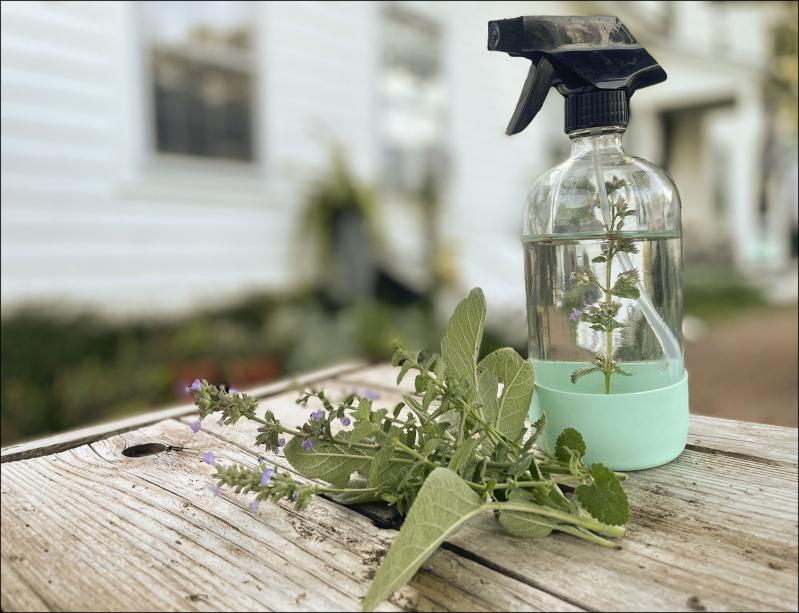I’m walking down the block holding my breath, trying to make it to the corner without inhaling. If I can’t, I know what I’m in for: a waft of Laundromat dryer sheet exhaust, the gag of a freshly Fabuloso’d sidewalk. It’s hard to remember when outside air smelled like . . . air.
Summer, a scent-cation for me, counterbalances months of indoor air altered by fragrant cleaning products, plug-ins, reed diffusers, and Febreze. I often run late, but always stop to smell the flowers, unself-conscious as I lean into a blooming privet that reminds me of cocoa or rise onto tippy toes to sniff a drooping lilac branch. Whenever I can, I rub tomato leaves between my fingers, place velvety sage on my cheek, or plunge my face into a pot of lavender or cat’s pajamas, a member of the mint family, Nepeta x faassenii, by the way.
My high sensitivity to smell began when I got pregnant and never left, and while you may detect complaining in the words that follow, I am merely reporting from the snifflines.
The hostile takeover of our airspace started pre-pandemic but was accelerated by it: a collective attempt to sanitize our lives with scents that scream “no germs here.” Indoor air pollution can be more dangerous than outdoor, and while it’s partly due to off-gassing furniture, cooking byproducts, and pets — i.e., living — we’ve also chosen to pollute our interiors with fragrance, both as standalone products and additives to already-toxic potions. Your living room ficus can only work so hard. This is not just a personal manifesto; it’s an outcry.
A quick primer: “Fragrance” or “parfum” are legally protected trade secrets that include proprietary blends of chemicals, two syllables that can contain hundreds of ingredients: phthalates, to make scents linger, volatile organic compounds (VOCs), synthetic stabilizers, and more. Studies link these to respiratory problems, skin irritation, allergic reactions, and endocrine disruption. Sometimes the word carcinogenic appears. And yet, we keep spraying, washing, and misting.
With scent everywhere, there’s a growing list of places I long to spend time but want to escape: a favorite pizza place where Fabuloso overpowers the fresh garlic knots; my kids’ schools (and the backpacks they tote home); my dad’s senior residence where a vase of Stargazer lilies can’t outmatch the mop bucket. Why must I return from every grocery shopping, doctor’s appointment, and hotel smelling like I (and my produce!) splashed into a dunk tank of cleaning fluid, or wrestled — and lost — with a can of air freshener? Uber: Can I request a ride without a scented tree hanging from the rearview mirror? No, I’d be waiting all night.
It can take us a while before we clue in to harm: secondhand smoke, electric and magnetic fields radiation, methane production, screen time. The anti-fragrance movement is slow, but has momentum. Consider this: The American Lung Association recommends swapping out commercial cleaning products for pantry basics: baking soda, vinegar, water, and Castile soap. Add a few drops of essential oil if you need to smell your own elbow grease. Protect your lungs and your wallet. Sorry, Procter & Gamble.
I’m rubbing off on people. My boys decline a barber’s offer to apply hair product. My aunt disposed of her Tide Pods; I’m working on her Swiffer solution. Friends apologize for their perfume when we hug hello. I’m not bossy, but I do turn into an olfactory dictator at home. I’ve politely asked babysitters to lose the lotion; my kids were kept safe but smelled like Sephora. Now, it’s time to extend beyond my bubble.
We have air pollution laws and noise codes, so why not indoor air regulation? If N.Y.C. can appoint a rat czar, surely we can install a scent czar. R.F.K., restore fluoride and we’ll let you go bananas on Fabuloso.
All said, I harbor contradictions. My happy place may be naturally fragrant places like the Madoo gardens or the Southampton Recycling Center, a.k.a. the dump, but I do keep an empty bottle of my mom’s Annick Goutal because one whiff of Eau d’Hadrien and I’m beside her again. Our olfactory system bypasses rational processing and goes straight to the limbic system, in charge of emotion (the amygdala) and memory (the hippocampus). It’s hard-wired, primal. I blush to admit that sometimes I’m drawn to a stranger’s aftershave or cologne. Congrats, Drakkar Noir, you’ve cracked my X chromosomal code and hacked my middle school brain.
Not long ago, my mother-in-law gave our son a bottle of Paco Rabanne Million Gold. After he left one morning, his scent still hovering over our eggs and toast, I turned to my husband: “Are you taking out your mother, or should I?” Though I’ve raised my family fragrance-free, there comes a time when a parent must let go. That time is not yet. But when my son returns, molecules mellowed by soccer and sweat, I’m fond of the sweet after-notes, a musky resolution that is uniquely him. I’ll let his identity unfold — just a spritz or four fewer, my boy.
I get it. Scent is personal. It can make us feel special, sensual, nostalgic, and clean. I know. I’ve dabbed patchouli on my wrists before a Zoom. But can we please protect shared spaces so we’re not poisoning ourselves? Let’s keep the air clear enough so that when we walk down a street or enter a business, we smell pine needles, and for heaven’s sake, that side of marinara.
Care for our air: Buy products vetted by the Environmental Working Group or Made Safe. Demand ingredient transparency. Push for fragrance-free schools, stores, offices, restaurants. Buy more plants.
Rachel A. Abrams is a UX designer, writer, and dancer who lives in Brooklyn and Sagaponack. She is online at rachelink.com.

